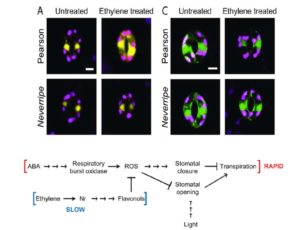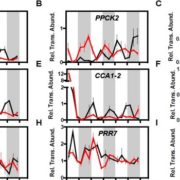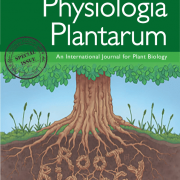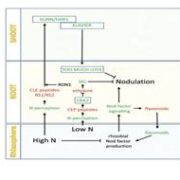Flavonols Modulate ROS in Tomato Guard Cells
 Although reactive oxygen species (ROS) have historically been considered damaging agents within cells, recent studies have demonstrated that these molecules also serve as second messengers in signaling pathways. The reactive nature of ROS allows these compounds to function as signaling molecules by reversibly oxidizing Cys residues in proteins, modulating enzyme structure or activity. Plant cells employ multiple mechanisms to regulate the levels of ROS to modulate signaling and prevent oxidative stress. One mechanism is the synthesis of flavonol metabolites that function as antioxidants in vitro and have been shown to modulate ROS-regulated processes. Flavonols are early intermediates in the flavonoid biosynthetic pathway, which gives rise to a variety of important specialized metabolites. Flavonol biosynthesis is hormonally regulated; auxin and ethylene have been shown to increase flavonol synthesis through changes in expression of the genes encoding pathway enzymes. In this issue, Watkins et al. (10.1104/pp.17.01010) examine the role of flavonol antioxidants in modulating signaling-induced ROS in tomato guard cells. The authors report that ABA-increased ROS is followed by stomatal closure and that both responses are blocked by inhibitors of ROS-producing respiratory burst oxidase enzymes. The accumulation of flavonol antioxidants in guard cells was visualized by confocal microscopy using a flavonol-specific fluorescent dye. An inverse relationship between flavonols and ROS was observed in tomato mutants.. Ethylene treatment of wild-type tomato plants increased flavonol accumulation in guard cells; however, no flavonol increases were observed in Neverripe (Nr), an ethylene receptor mutant. Consistent with lower levels of ROS due to elevated flavonols, ethylene treatments decreased ABA-induced stomatal closure in the wild type, but not Nr. Together, these results are consistent with flavonols dampening the ABA- dependent ROS burst that drives stomatal closure.
Although reactive oxygen species (ROS) have historically been considered damaging agents within cells, recent studies have demonstrated that these molecules also serve as second messengers in signaling pathways. The reactive nature of ROS allows these compounds to function as signaling molecules by reversibly oxidizing Cys residues in proteins, modulating enzyme structure or activity. Plant cells employ multiple mechanisms to regulate the levels of ROS to modulate signaling and prevent oxidative stress. One mechanism is the synthesis of flavonol metabolites that function as antioxidants in vitro and have been shown to modulate ROS-regulated processes. Flavonols are early intermediates in the flavonoid biosynthetic pathway, which gives rise to a variety of important specialized metabolites. Flavonol biosynthesis is hormonally regulated; auxin and ethylene have been shown to increase flavonol synthesis through changes in expression of the genes encoding pathway enzymes. In this issue, Watkins et al. (10.1104/pp.17.01010) examine the role of flavonol antioxidants in modulating signaling-induced ROS in tomato guard cells. The authors report that ABA-increased ROS is followed by stomatal closure and that both responses are blocked by inhibitors of ROS-producing respiratory burst oxidase enzymes. The accumulation of flavonol antioxidants in guard cells was visualized by confocal microscopy using a flavonol-specific fluorescent dye. An inverse relationship between flavonols and ROS was observed in tomato mutants.. Ethylene treatment of wild-type tomato plants increased flavonol accumulation in guard cells; however, no flavonol increases were observed in Neverripe (Nr), an ethylene receptor mutant. Consistent with lower levels of ROS due to elevated flavonols, ethylene treatments decreased ABA-induced stomatal closure in the wild type, but not Nr. Together, these results are consistent with flavonols dampening the ABA- dependent ROS burst that drives stomatal closure.









